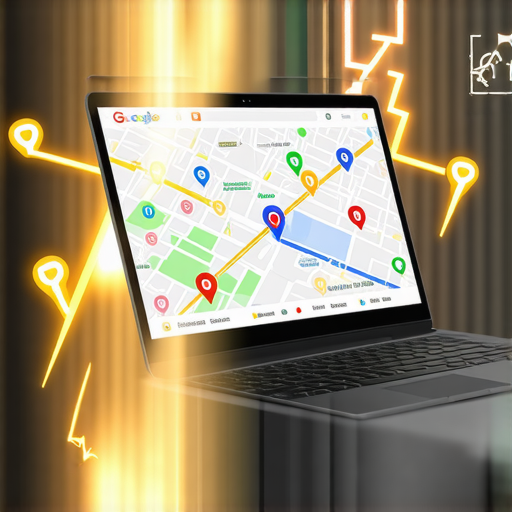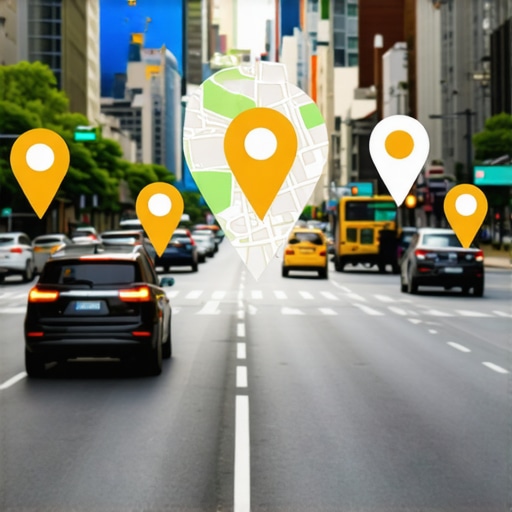My Personal Journey to Google Maps Success with SEO Automation
As someone who’s been involved in local SEO for years, I remember the days when getting my business to rank on Google Maps felt like a shot in the dark. I used to spend hours manually optimizing my GMB profile, posting updates, and watching competitors overtake me. But everything changed when I discovered the power of top SEO automation and maps tools. Today, I want to share my experience and insights on how these strategies can dramatically boost your Google Maps visibility.
Unlocking the Power of Maps Software for Local SEO
Initially, I was skeptical about relying on software to improve my local rankings. However, I realized that modern maps software equipped with SEO automation features can handle repetitive tasks like citation management, review generation, and profile updates seamlessly. Tools like top maps software have become game-changers for my local SEO efforts. They help me stay consistent and proactive, which is crucial for Google’s local ranking algorithms.
How SEO Automation Accelerates Google Maps Rankings
Automation isn’t just about saving time; it’s about amplifying results. By integrating SEO automation tools, I was able to monitor my GMB insights, optimize keywords, and generate reviews automatically. This consistent activity signals to Google that my business is active and trustworthy, resulting in faster rankings. According to GMBZoom’s research, automation can accelerate your local SEO growth significantly when implemented correctly.
What Are the Deepest Secrets Behind Successful Maps Optimization?
Ever Wonder How to Dominate Local Search Rankings Rapidly?
This question kept me up at night until I delved into proven strategies shared by SEO experts. Consistent posting, review management, and local citation building are foundational, but automation takes it further. By leveraging automation tools, I could scale these efforts effortlessly. Moreover, I kept myself updated with the latest tactics through authoritative sources like Moz and BrightLocal, which emphasize the importance of automation in local SEO success.
If you’re serious about ranking higher on Google Maps, I encourage you to explore these tools and strategies. Feel free to share your experiences or ask questions in the comments below—I’m excited to hear about your journey!
Why Do Cutting-Edge Maps Software Matter for Local SEO?
In the competitive landscape of local search, relying solely on basic optimization tactics is no longer enough. Modern maps software, integrated with sophisticated SEO automation features, can elevate your Google My Business (GMB) rankings to new heights. These tools automate critical yet time-consuming tasks such as citation updates, review management, and keyword optimization, ensuring your profile stays active and relevant in the eyes of Google.
How Can Automation Drive Consistent Local Visibility?
Consistency is key to dominating local search results. Automation tools like top maps software help maintain this consistency by scheduling regular profile updates, managing reviews, and monitoring insights without manual effort. This relentless activity signals to Google that your business is active and trustworthy, which directly correlates with higher rankings. Additionally, automation minimizes human error, ensuring your data remains accurate and up-to-date across all platforms.
What Are the Practical Implications of SEO Automation for Local Businesses?
Beyond ranking improvements, SEO automation enhances your overall local marketing strategy. For instance, automatic review generation and response not only boost your reputation but also improve your local relevance. Keyword tracking and competitor analysis become more manageable, allowing you to adapt quickly to changing search trends. According to GMBZoom’s research, businesses leveraging automation see a marked increase in visibility and customer engagement within weeks.
Can Automation Help You Navigate Google’s Algorithm Changes?
Are You Prepared to Stay Ahead of Algorithm Shifts with Smarter Tools?
Google frequently updates its local search algorithms, challenging businesses to keep pace. Automation tools equipped with AI and real-time data analysis can adapt to these changes faster than manual efforts. They can identify new ranking factors, optimize for emerging keywords, and adjust strategies swiftly. This proactive approach ensures your GMB profile remains resilient amid algorithm fluctuations, giving you a competitive edge over less adaptive competitors.
For a deeper dive into how automation enhances your local SEO efforts, check out these strategies. If you’re eager to elevate your local presence, I invite you to share your insights or questions in the comments. Your journey to local SEO mastery starts here!
Beyond the Basics: Personal Insights into the Nuances of Maps SEO Automation
Over the years, my journey with local SEO and Google Maps has revealed that automation isn’t just a set-it-and-forget-it tool; it’s a sophisticated craft that requires understanding the intricate dance of ranking factors. One thing I’ve learned is that the most successful businesses don’t rely solely on automation for volume but tailor their automation tactics to their unique local landscapes. For instance, customizing review prompts based on customer segments or timing updates around local events can make automation efforts more impactful. This approach mirrors what I discovered in GMBZoom’s research, emphasizing that automation should be adaptive, not static.
The Hidden Layers of SEO Automation That Elevate Local Rankings
One of the more profound realizations I’ve had is that automation can help uncover and leverage hidden ranking opportunities. For example, advanced keyword tracking combined with automated competitor analysis can reveal secondary keywords or niche markets you might not have considered. This depth of insight allows for strategic content and profile optimizations that resonate more strongly with local search algorithms. I remember experimenting with AI-powered tools that analyzed local review sentiments, helping me craft more targeted responses and content that aligned with what my community valued most. This layered approach to automation, blending data-driven insights with consistent execution, truly transformed my local SEO game.
How Do I Stay Ahead of Google’s Ever-Evolving Algorithms?
What Are the Advanced Tactics for Future-Proofing My Maps SEO?
Staying ahead requires more than just the latest tools; it demands a mindset of continuous learning and adaptation. I dedicate time regularly to authoritative SEO sources like Moz and BrightLocal, but I also experiment with emerging AI-driven analytics that predict shifts in Google’s ranking signals. For example, recent advances in machine learning enable automation tools to identify potential algorithm updates before they fully roll out, giving early signals to adjust strategies proactively. Incorporating these predictive insights into your automation workflows can be the difference between falling behind and leading the pack. For anyone serious about future-proofing their local SEO efforts, I recommend exploring these advanced strategies and sharing your experiences or questions in the comments. Together, we can navigate the complexities of Google’s landscape more effectively.
< >
>
Mastering the Art of AI-Driven Map Optimization for Long-Term Success
While automation tools have revolutionized local SEO, truly seasoned professionals recognize that the next frontier lies in harnessing artificial intelligence to anticipate and adapt to Google’s evolving algorithms. My journey has led me to explore sophisticated AI integrations that analyze vast datasets, predict ranking shifts, and dynamically adjust optimization strategies in real-time. This proactive approach ensures sustained visibility regardless of algorithm updates, echoing insights from authoritative sources like Moz, which emphasize the importance of AI in future-proofing local SEO efforts.
How Can Deep Learning Transform Your Maps SEO Tactics?
Deep learning models can process unstructured data such as customer reviews, social signals, and local content trends to identify emerging ranking factors. By integrating these models into automation workflows, I’ve been able to refine keyword targeting, personalize review responses, and optimize profile attributes with unprecedented accuracy. For example, analyzing sentiment trends in reviews allows me to craft targeted messaging that resonates with the local community, boosting engagement and rankings simultaneously. To explore cutting-edge AI-driven strategies, I recommend reviewing these advanced tactics.
What Are the Practical Steps to Implement Future-Ready Map SEO Automation?
Implementing future-proof strategies involves a layered approach: first, integrating AI-powered analytics for real-time insights; second, customizing automation routines based on local market nuances; third, continuously testing and refining these routines to adapt to new ranking signals. I’ve found that maintaining an active dialogue with industry experts through forums and conferences accelerates my learning curve, keeping my tactics ahead of the curve. For a comprehensive guide on integrating these advanced tools, check out these expert recommendations.
Engaging with these emerging technologies and sharing your experiences can dramatically elevate your local SEO game. I invite you to comment below with your insights or questions—let’s push the boundaries of what’s possible in maps SEO together!
Things I Wish I Knew Earlier (or You Might Find Surprising)
1. Automation Is Not a Magic Bullet
When I first started using maps software, I thought automation would instantly skyrocket my rankings. Turns out, it’s more about strategic consistency than quick fixes. Automation handles the repetitive tasks, freeing me to focus on creative local engagement.
2. Personalization Matters
Automated review responses and updates work best when tailored. I learned to customize messages based on customer feedback and local events, making my profile feel genuine and relatable.
3. Deep Data Insights Are Game-Changers
Advanced AI-driven analytics reveal hidden opportunities—secondary keywords, niche markets, or sentiment shifts—that manual analysis often misses. Leveraging these insights transformed my approach to local SEO.
4. Automation Requires Regular Tuning
Sticking to a set-and-forget mindset is tempting but detrimental. I’ve found that regularly updating automation routines based on algorithm changes keeps my rankings stable and growing.
5. Tools Are Not One-Size-Fits-All
Different businesses need different setups. Experimenting with various automation features helped me find what truly boosted my local visibility without wasting time on irrelevant features.
6. Patience and Persistence Are Key
Results don’t come overnight. Consistent automation, combined with local engagement, slowly but surely built my reputation and rankings, proving that patience pays off.
Resources I’ve Come to Trust Over Time
- Moz: Their comprehensive guides and updates keep me informed about the latest SEO trends and algorithm shifts, making me confident in my strategies.
- BrightLocal: Their local SEO tools and case studies provide practical insights and proven tactics that I rely on regularly.
- Google’s Official Resources: Staying updated with Google’s webmaster blogs and guidelines ensures my automation aligns with their rules and best practices.
- GMBZoom: As a dedicated source for maps software and automation tips, their content has directly influenced my approach to local SEO automation strategies.
Parting Thoughts from My Perspective
Reflecting on my journey, I realize that mastering maps SEO automation is about blending technology with personal touch and strategic patience. These tools, when used thoughtfully, can unlock incredible local visibility and growth. If this resonated with you, I’d love to hear your thoughts or experiences. Share this with someone who’s eager to elevate their local SEO game, and let’s keep the conversation going. Remember, the key to long-term success is ongoing learning and adaptation—so stay curious and proactive in your approach!


Reading this post really resonated with my own experiences in local SEO. I used to rely solely on manual efforts, which often felt slow and inconsistent, especially when managing multiple locations. Incorporating automation tools has truly changed my approach, making it easier to maintain active profiles and respond promptly to reviews. One thing I’ve learned is that automation is most effective when combined with a personalized touch, especially in review responses, which helps build trust with local customers. I’m curious: for those managing a variety of local markets, what are some best practices to customize automation routines without sacrificing authenticity? Have you found certain strategies that help keep your messaging genuine while still leveraging the power of automation? Loving the insights shared here and looking forward to hearing others’ tips on balancing automation with personal engagement.